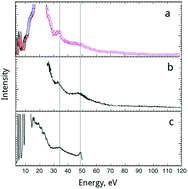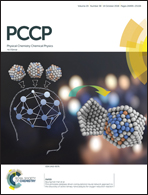Study of volume and surface plasmons in small silicon–hydrogen nanoclusters using the GW method†
Abstract
Numerical calculations of surface and volume plasma excitations in silicon–hydrogen nanoclusters in the range Si10–Si60 and Si3H8–Si64H56 (size range 4–13.5 Å) are performed within the GW approximation. Some nanocluster structures were obtained using the evolutionary algorithm, and others were taken from the database. The applied method shows the results to be consistent with the experiments (except plasmaron artifacts) for fullerene clusters and bulk silicon along with sufficient sensitivity to allow investigatation of the effect of the cluster structure and size on the specific properties of plasma excitations. Detailed experimental data on plasmons are mainly available for silicon clusters of 30 Å and more, in which plasmon properties do not differ much from those in bulk silicon. Calculations show that in the studied nanoclusters the situation changes noticeably. The structure and surface of the cluster begin to affect the plasmons in a key way, structures close in size and composition may have markedly different plasmon properties. Passivation of silicon dangling bonds on the cluster surface changes frequency and damping of plasmons, making the surface and volume plasmons clearly distinguishable even in small nanoclusters as Si3H8.



 Please wait while we load your content...
Please wait while we load your content...